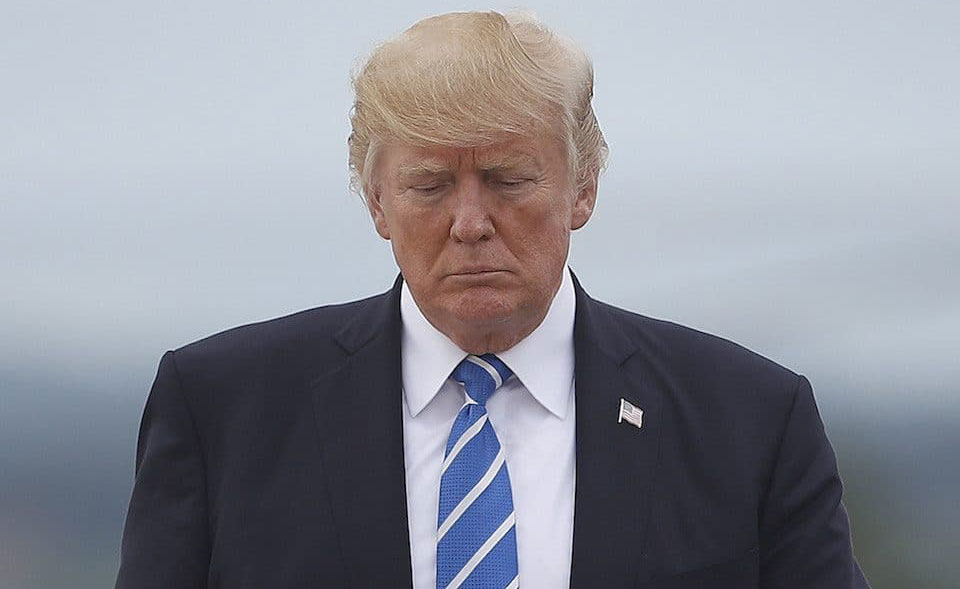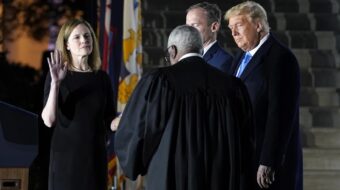
NEW YORK—Millions of workers potentially won—and the GOP Trump regime lost in court again—as a New York federal judge tossed the Trump Labor Department’s new, and narrower, “joint employer” rule.
Indeed, the Trump scheme was so bad, said Judge Gregory Woods of the U.S. District Court for Southern New York, that “It conflicts with the FLSA {Fair Labor Standards Act] because it ignores the statute’s broad definitions” of which workers the act covers.
“The department failed to adequately justify its departure from its prior interpretations and to account for some of the final rule’s important costs. So the final rule is also arbitrary and capricious,” Woods added in his Sept. 8 decision.
Though Trump’s Labor Department could contest Woods’ ruling in higher courts, it’s a victory for millions of workers who suffer from rule by two employers, such as a corporate headquarters—think McDonald’s—and its local franchise-holder. The 18 state attorneys general who challenged it said low-income workers, in particular, would win if Trump’s DOL lost.
The decision also continues Trump’s losing streak in courts on federal rules. As of September 14, a New York University Law School analysis shows, state Attorneys General, public interest groups, and others have challenged 132 Trump rules. Virtually all were rollbacks or cancellations of rules protecting workers, consumers, and the environment. The groups’ record is 111 wins against Trump and 21 losses.
The wins include the Trump Labor Department’s joint employer rule.
Trump’s rule which Woods tossed “undermines critical workplace protections for the country’s low-and middle-income workers and could lead to increased wage theft and other labor law violations,” said the leader of the AGs, New York’s Letitia James. AGs from D.C., Minnesota, Maryland, Michigan, Oregon, Pennsylvania, and Illinois were also among the challengers.
This is an important win for workers,” said Heidi Shierholz, Policy Director of the Economic Policy Institute and DOL’s chief economist during the Democratic Obama administration. In a friend of the court brief, “EPI estimated the rule would cost workers more than $1 billion annually by increasing wage theft and by incentivizing workplace fissuring.”
Trump’s Labor Department “dramatically narrowed the set of circumstances where a firm can be found to be a joint employer under the FLSA,” she explained. That New Deal law “is our nation’s fundamental worker protection statute, providing wage and hour protections to the vast majority of U.S. workers.”
“It was drafted broadly, creating employer coverage to ensure that companies that use staffing, temp, or subcontractors in their business operations are held accountable” for obeying its minimum wage and overtime pay provisions, plus its ban on child labor.
“The Trump DOL’s rule would have made it nearly impossible for many workers to enforce these rights and would have taken away the ability of workers to recover unpaid wages from firms who use low-wage contractors in their work.”
Those workers face dilemmas when their “employer” breaks labor laws. When the “joint employer” allegedly breaks the National Labor Relations Act, Trump’s three-white-man, all-right wing labor board decides if the local franchise or the corporate headquarters is responsible.
And Trump’s labor board, reversing an Obama NLRB ruling that said both the headquarters and the local franchise are responsible, leaves the workers twisting in the wind.
But when the employer(s) don’t pay workers the minimum wage, the tipped minimum wage or overtime, DOL gets into the act, enforcing the Fair Labor Standards Act. Trump’s DOL promulgated a rule in January to let more employers get away with that law-breaking. The AGs sued and won, as Woods said “vertical” employers, such as a construction contractor and a subcontractor, are joint employers under that wage and hour law.
“Under the FLSA, a court must look not to ’isolated factors but rather [to] the circumstances of the whole activity,’’ of working, Woods wrote. “The touchstone is ‘economic reality.’”
Many factors “determine whether a worker economically depend[s] on a purported employer, thus creating an employment relationship…A test that focuses solely on the formal right to control the physical performance of another’s work is unduly narrow.”
But that’s what DOL proposed, and Woods tossed it.
Even DOL admitted workers could lose money under its joint employer rule because many would lose the right to sue for unpaid wages and overtime, Woods noted. But DOL said that even among 57,000 comments, it couldn’t find a figure for how much workers would lose. Woods found it in EPI’s friend of the court brief.
The attorneys general applauded the win, but noted the fight to get joint employers to obey labor laws isn’t over. That’s because the NLRB’s joint employer rule—which covers unfair labor practice cases, such as who workers can bargain with for a contract—still stands. Another coalition of 25 AGs is challenging that rule, too, Michigan’s Dana Nessel said.
That NLRB joint employer rule “undermines” the National Labor Relations Act and its protections of worker rights, those AGs’ protest said. And the AGs, Nessel added, “raises questions about the integrity of this rulemaking, which attempts to push forward the same joint-employer standard adopted in a 2017 NLRB later thrown out because of a potential conflict of interest by one of the deciding NLRB members,” William Emanuel, named by Trump. Emanuel’s pro-boss labor law firm represented a joint employer that defied the Obama-era NLRB’s rule.












Comments